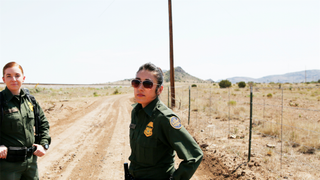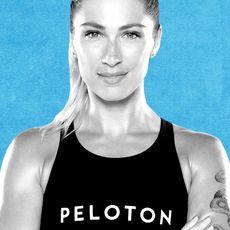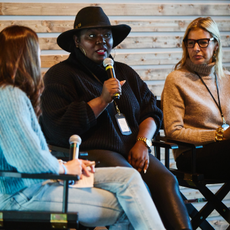What It's Like to Be a Female Border Patrol Agent
Travel bans. Threats to dismantle DACA. The wall. Since taking office in January, President Donald Trump has kept immigration a hot-button issue. As the U.S. Border Patrol reels from reports of sexual misconduct by male agents and a tepid campaign to recruit more women, Sasha Von Oldershausen goes behind the scenes of life on the border.
At a windswept rest stop along Highway 10, located between Van Horn and El Paso, Texas—some 18 miles from the U.S.–Mexico border—we are looking for “sign.” That’s Border Patrol–speak for physical evidence of human disturbance in the crumbling West Texas dirt. In this instance, the sign is three sets of footprints. “Two prints made by boots, and the third looks like cheese graters,” radio the agents who first spotted the prints south of our location.
Diana Martinez, a 24-year-old U.S. Border Patrol agent who works in the Big Bend Sector, radios back that we’ve caught sight of the “cheese grater” soles, but not the other two. This is protocol: Multiple agents assemble at different points along a line of footprints and leapfrog one another until they intercept the path of the prints’ owner. Sometimes, the markings are nothing more than those of local residents. Other times, they lead to no one. But once in a while, the agents find what they’re looking for: undocumented people crossing the border illegally or drug-toting smugglers.
Two other agents follow the prints behind a line of barbed-wire fence several yards from the rest-stop bathrooms. Moments later, a voice crackles over Martinez’s radio: “We got them.”

Agent Talia Leyva at a checkpoint on the U.S.-Mexico border.
The agents emerge from the squat mesquite brush with three 30-something men: two wearing boots and one in canvas sneakers. The trio had traveled nearly 300 miles over nine days through the Chihuahuan Desert from the town of Delicias, Mexico. They had arranged to be picked up at the rest area, but when their ride never came, they camped out in the brush, just yards from the highway.
Martinez and I follow behind them, ambling to the Border Patrol SUVs parked at the rest-stop pull-off. Two of the men are shirtless; one’s ribs jut impressions through his sun-scorched skin as clear as his footprints in the dust. They carry no physical
baggage besides their clothes, and silently follow the agents.
Only 5 percent of Border Patrol agents are women.
The Van Horn Station, where Martinez works, is just one of more than 70 along the nearly 2,000 miles of the U.S.–Mexico border. The vast swath of land is divided into nine sectors, each made up of several patrol stations, checkpoints, and monitoring
technology (towers with radar and infrared cameras, trucks mounted with laser range finders, underground sensors, as well as helicopters and unmanned drones). In total, there are some 17,000 agents manning these stations, out of the more than 21,000 who make up the U.S. Border Patrol force (which also includes stations on the U.S.–Canada border and a handful of coastal offices). This year, migrant traffic is down significantly from the major surges the U.S. saw in 2014 and 2016 as a result of violence in Central America, yet the agents’ mission remains the same: secure the borders from illegal entry. The agency is led by Carla Provost, who was appointed in April and is the first woman in its 93-year history to serve as chief. Still, only 5 percent of agents are women. And that, Border Patrol leadership has realized, is a problem.
RELATED STORY

In 2014, the Border Patrol launched a recruitment campaign targeting women (one TV ad featured a uniformed woman standing in the desert next to the words “Hiring Women Agents; Apply Now.”). The campaign coincided with two key events: a 173 percent increase in the number of female migrants crossing the southwest border since 2011, and the implementation of a zero-tolerance policy on sexual abuse and assault of individuals in its custody by the Border Patrol’s parent agency, Customs and Border Protection (CBP), in 2015.
Stay In The Know
Marie Claire email subscribers get intel on fashion and beauty trends, hot-off-the-press celebrity news, and more. Sign up here.
Allegations of sexual misconduct by male agents against migrants—among other allegations of misconduct, including excessive force—have cast a cloud on the federal agency. A 2015 CBS News investigation reported 285 documented complaints of sexual misconduct by CBP officers or agents between 2009 and 2015, including 44 open and ongoing investigations.
In the CBS coverage, James Tomsheck, the chief of internal affairs at the CBP from 2006 to 2014, attributed the bad behavior to the agency’s post-9/11 hiring surge. As part of a massive security push, the Bush administration and Congress added nearly 10,000 Border Patrol agents between 2001 and 2008, almost doubling the size of the agency. With this dramatic growth came an increase in cases of misconduct and corruption, as well as speculation that applicants were not adequately vetted. The frequency of these cases prompted Congress to mandate a polygraph test—which covers everything from petty crimes to potential relationships with drug cartels—as part of its vetting system for new recruits in 2010.
Migrant women and girls are already vulnerable to sexual violence at the hands of criminal gangs and human traffickers. According to Amnesty International, an estimated 60 percent have been raped while traveling to the U.S.–Mexico border, and it is common practice for women to take contraceptives before their journey to prepare for the possibility of rape. The CBP’s zero-tolerance policy, which generally prohibits agents of the opposite sex from patting down detainees, was created in part as a response to criticism the agency faced owing to the high incidence of sexual-misconduct allegations by detainees. But paper policies don’t always work.
An estimated 60 percent of migrant women and girls have been raped while traveling to the U.S.–Mexico border.
In July 2016, two Guatemalan sisters who illegally crossed the border alleged that a Border Patrol agent from the Presidio Station in the Big Bend Sector forced them to strip, before sexually assaulting them. Nineteen-year-old “Clarita” (a pseudonym for one of the women) said the agent took her into a closet-like room, blocked the door, and asked her to remove her clothes. “He said this was to make sure I wasn’t carrying anything illegal. But he didn’t stop there. He lifted my bra, placed his hands inside, and caressed my breasts,” she wrote on the American Civil Liberties Union (ACLU) website in March 2017. “He started to forcefully pull down my underwear. He
touched me inappropriately, running his hand over my vagina.” Clarita said he did the same to her 17-year-old sister. Attorneys at the ACLU have filed legal claims against the Department of Homeland Security (DHS) on behalf of the sisters. The DHS Office of Inspector General has since launched an investigation into the case, which is pending. (The Presidio Station still doesn’t have a single female agent.)

'Agents Chloe Beecher (left) and Talia Leyva spend hours in the 100-degree heat chasing footprints in the dust.
The CBP itself seems eager to promote the post-gender notion that there’s no difference between male and female agents. “Everybody’s got to do the same job,” says Rush Carter, special operations supervisor at the Big Bend Sector office, though he admits, “Are there certain things that women agents can definitely do better, like patting down a female? Certainly.”
During her two years on the job, Chloe Beecher, a 25-year-old agent who works at the Marfa Station within the Big Bend Sector, says she’s noticed a difference in the way female detainees tend to interact with male versus female agents. “A lot of females don’t want to talk to male agents, so they’ll keep their head down or just be super-quiet. It’s important to have a female who can relate to them, talk to them, get more information out of them if they’re willing,” she says. The Border Patrol’s 2014 campaign to recruit more women yielded 175 female hires—a far cry from the 1,600 it was aiming for. “It really stinks that you don’t have a female agent down in Presidio or a female Department of Public Safety trooper who can go down and search a female,” Beecher says.
RELATED STORY

Earlier this year, President Trump ordered another hiring spree, calling for an additional 5,000 Border Patrol agents, as well as a waiver for some applicants on the polygraph test to speed up the hiring process. The administration has not specified a timetable or a recruitment strategy, nor whether it will attempt to recruit more women.
The nature of the job is daunting, regardless of gender. There are physical challenges: Agents attend the Border Patrol Academy in Artesia, New Mexico, which includes five months of rigorous obstacle courses, firearms training, and simulated apprehensions. There are environmental challenges: Big Bend agents clock eight- to 10-hour shifts outside in temperatures that regularly rise above 100°F from June to September, wearing thick dark-green canvas uniforms that offer little relief. And there are mental ones: Most days are filled with hours of solitude. Martinez, who joined in 2015, says she usually drives along lonely roads, traversing the 29 miles of border that fall under the Van Horn Station’s jurisdiction, peering out her open window for footprints. Sometimes, if she thinks she’s found sign, she’ll hike along its path. “There’s no backup two minutes away,” explains Darla Seyffert, Martinez’s supervisor and one of three women at that station. “She’s expected to track a group of people who don’t want to get caught, and she’ll come up solo on a group of men and have to take control of a situation.”
Much of the border is remote, rough terrain, so signing up to be an agent often means giving up the comforts of living in a bigger city. Though the Big Bend Sector, which sits on the Rio Grande, encompasses the largest geographical area of any sector (165,000 square miles, or almost a quarter of the southwest border), it employs the smallest staff. As a result, agents are tasked with patrolling immense stretches of land, including 510 miles of border. The mountainous desert landscape provides enough of a natural barrier to restrict the volume of illegal immigration—a fact critics of Trump’s wall, including people within the Border Patrol, cite as a reason that a wall isn’t necessary. (The number of apprehensions in the Big Bend Sector in 2016 was the lowest of all southwest-border sectors.) Agents who work within that sector get stunning desert vistas and starting annual salaries of $52,000 in exchange for life in towns where the nearest hospital is 90 miles away and the closest Walmart is a 200-mile drive.
You have to remove yourself in order to survive in this type of job.
Marisela Quinones, a 45-year-old supervisor at the Sierra Blanca checkpoint, was a single mother of two when she joined the agency 14 years ago. Her station, one of 33 permanent traffic checkpoints situated along the southern border, sees between 7,000 and 10,000 vehicles traveling from Juárez, Mexico, on a daily basis. Her 27-person team is responsible for checking for concealed humans and narcotics. Typically, this involves a canine handler, whose dog sniffs out the cars while another agent asks for proof of citizenship from passengers. If the dog picks up on a scent, the vehicle is subject to a thorough search—without a warrant. It’s a strenuous job, compounded by the hour-plus commute Quinones makes each way to and from her home in El Paso. “It does take a toll on you—on your family, on your body, on everything,” she explains. “You don’t sleep right, you don’t eat right.”
There’s no escaping the fact that these women work in a male-dominated field. Several I spoke to describe pressures to “prove themselves,” making them more inclined to look at other women in the field as competition instead of comrades. Beecher says she had a disproportionate number of women in her Border Patrol Academy class: “I’ll be completely honest. I was not quick to become friends with any of those females there,” she says. “I don’t want to be that person who’s like, ‘Oh, she’s always hanging out with females. She doesn’t think she can fit in with men.’”
The realities of the job toughen you, says Quinones. The first time she witnessed a family being apprehended,“I just cried to myself,” she says. “Like, Get it together. You’re here for a reason.” The monitor behind her displays camera views of the rooms that hold detainees at the checkpoint. A woman sits on a bench in a detention cell while two young girls—one a toddler—play on the ground. The woman is Guatemalan and undocumented, Quinones tells me, and was attempting to smuggle three people in her trunk for profit, with her children, who are American citizens, in the car. Quinones says they would most likely be put in the custody of Child Protective Services. I ask her if it is difficult to see this family. “It doesn’t break my heart with her, but the kids, yeah...You have to remove yourself,” she says, “in order to survive in this type of job.”
Quinones aspires to become the patrol agent in charge of a station, the highest position available within a station, with an average salary of about $100,000. The promotion would significantly up Quinones’ responsibilities and the square mileage of terrain she oversees. But not all rewards of the job are so measurable. “I’m proud of being a female supervisor,” she says. “I’ve been able to prove a lot of people wrong.”
This article appears in the Holiday 2017 issue of Marie Claire, on newsstands now.
-
 Everything We Know About Paris Hilton and Nicole Richie's New Reality Show
Everything We Know About Paris Hilton and Nicole Richie's New Reality ShowThe '00s icons are reunited for a new reality show—which won't be a reboot of 'The Simple Life.'
By Sadie Bell Published
-
 Hunter Schafer Proves Pockets Belong on the Cannes Red Carpet
Hunter Schafer Proves Pockets Belong on the Cannes Red CarpetShe could carry her phone with her if she wanted.
By Halie LeSavage Published
-
 The Cast of 'The Strangers: Chapter 1' Plays 'How Well Do You Know Your Co-Star?'
The Cast of 'The Strangers: Chapter 1' Plays 'How Well Do You Know Your Co-Star?'We'd love to get a look at their Netflix queues.
By Quinci LeGardye Published
-
 Peloton’s Selena Samuela on Turning Tragedy Into Strength
Peloton’s Selena Samuela on Turning Tragedy Into StrengthBefore becoming a powerhouse cycling instructor, Selena Samuela was an immigrant trying to adjust to new environments and new versions of herself.
By Emily Tisch Sussman Published
-
 This Mutual Fund Firm Is Helping to Create a More Sustainable Future
This Mutual Fund Firm Is Helping to Create a More Sustainable FutureAmy Domini and her firm, Domini Impact Investments LLC, are inspiring a greater and greener world—one investor at a time.
By Sponsored Published
-
 Power Players Build on Success
Power Players Build on Success"The New Normal" left some brands stronger than ever. We asked then what lies ahead.
By Maria Ricapito Published
-
 Don't Stress! You Can Get in Good Shape Money-wise
Don't Stress! You Can Get in Good Shape Money-wiseYes, maybe you eat paleo and have mastered crow pose, but do you practice financial wellness?
By Sallie Krawcheck Published
-
 The Book Club Revolution
The Book Club RevolutionLots of women are voracious readers. Other women are capitalizing on that.
By Lily Herman Published
-
 The Future of Women and Work
The Future of Women and WorkThe pandemic has completely upended how we do our jobs. This is Marie Claire's guide to navigating your career in a COVID-19 world.
By Megan DiTrolio Published
-
 Black-Owned Coworking Spaces Are Providing a Safe Haven for POC
Black-Owned Coworking Spaces Are Providing a Safe Haven for POCFor people of color, many of whom prefer to WFH, inclusive coworking spaces don't just offer a place to work—they cultivate community.
By Megan DiTrolio Published
-
 Where Did All My Work Friends Go?
Where Did All My Work Friends Go?The pandemic has forced our work friendships to evolve. Will they ever be the same?
By Rachel Epstein Published